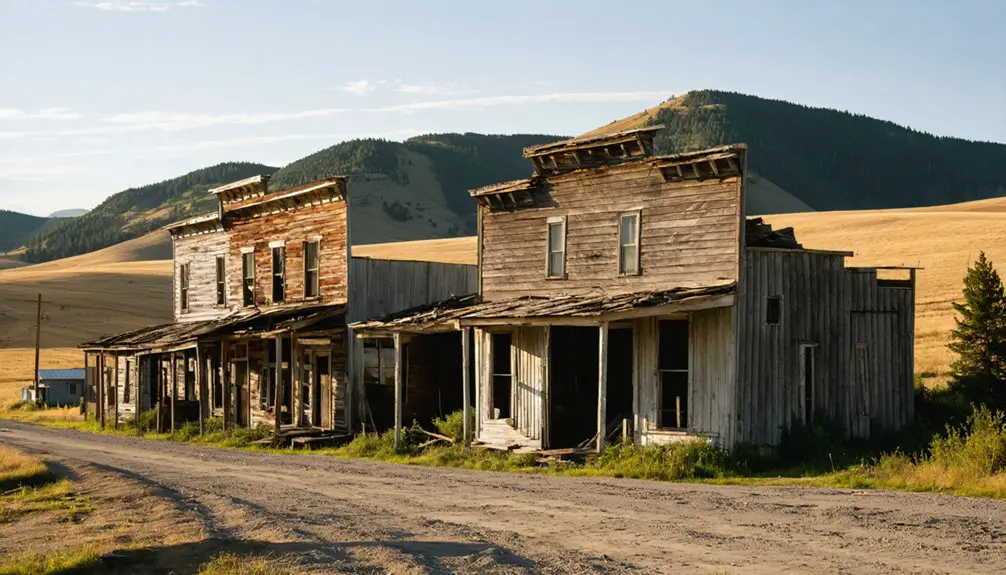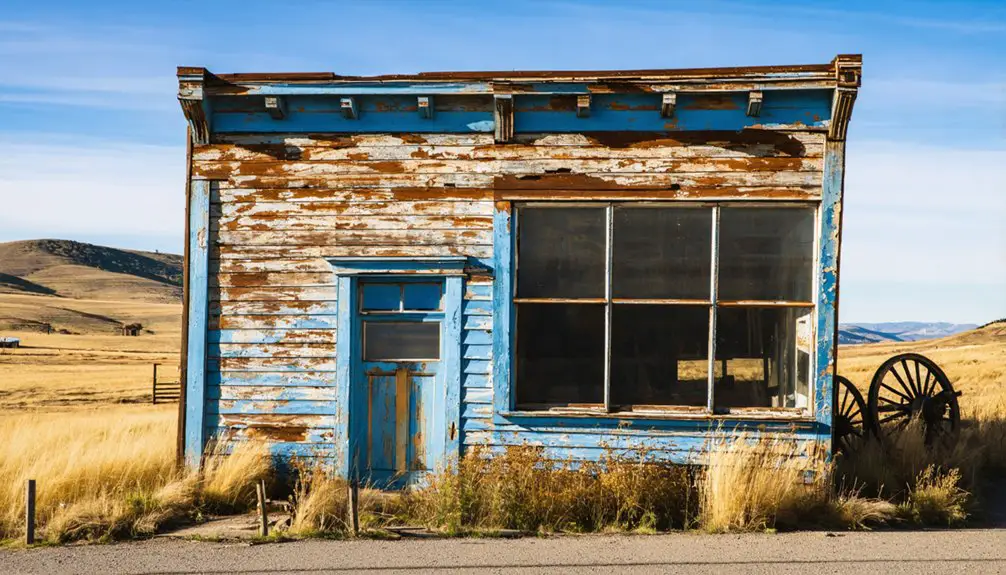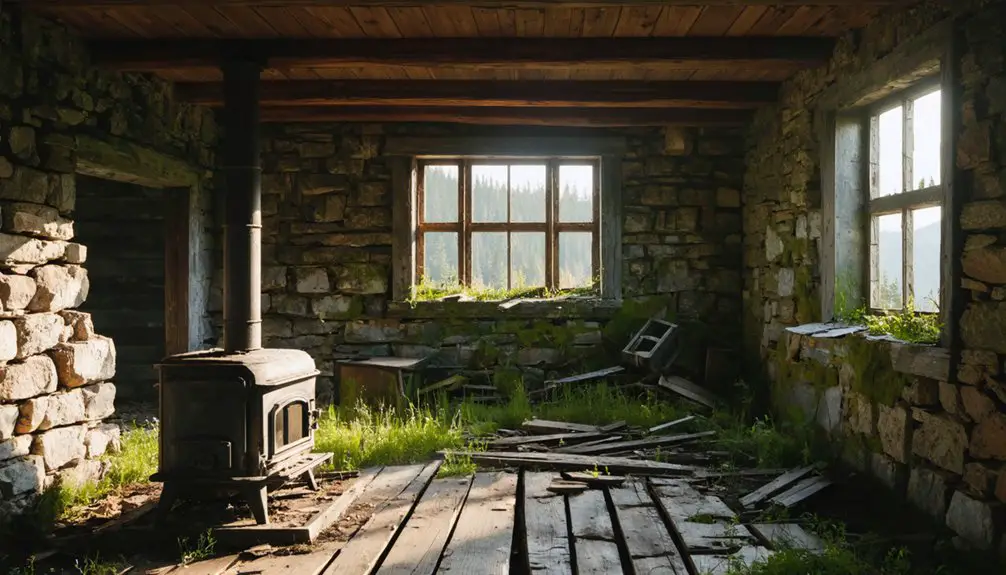You’ll find the ghost town of Kopiah nestled 8 miles southeast of Centralia, Washington, where a thriving logging community once stood. From 1906 to 1928, this Lewis County settlement peaked with 298 residents, anchored by its post office and schoolhouse as essential community hubs. The town’s population plummeted to 115 by 1930, and today virtually no structures remain. Kopiah’s story echoes a familiar pattern of early 20th-century rural settlements that vanished from Washington’s landscape.
Key Takeaways
- Kopiah was established in 1906 as a logging community in Lewis County, Washington, located 8 miles southeast of Centralia.
- The town reached its peak population of 298 residents in 1910, with the post office serving as the community’s social hub.
- Economic decline began when the town failed to secure railroad connections and depleted its local timber resources.
- The closure of the post office in 1928 marked a turning point, leading to rapid population decline to 115 residents by 1930.
- Today, Kopiah is completely abandoned with no remaining structures, making it one of Washington’s ghost towns.
Early Settlement and Origins
When settlers established Kopiah in 1906, they chose a strategic location just 8 miles southeast of Centralia in Lewis County, Washington.
They quickly set up a post office, marking the town’s official recognition and creating an essential communication link to the outside world.
The pioneers of the town, like their counterparts in neighboring regions, embraced various headwear including the traditional peci cap which reflected the diverse cultural influences in early Washington communities.
Settlement patterns reflected the era’s opportunities, with pioneers likely drawn to logging, farming, and trade prospects in the area.
Like many pioneer towns that emerged between Western and Eastern Washington, Kopiah represented the diverse landscapes and opportunities the state provided.
Life in Peak Years (1906-1920)
During Kopiah’s bustling peak years, you’d find the post office serving as the heart of daily community life, where residents gathered to collect mail and exchange news between 1906 and 1928.
Similar to mining district offices in Nighthawk, the post office was a central hub for local business and social gatherings.
The town’s modest population of 298 residents in 1910 meant you’d likely recognize every face at the post office, where logging crews and their families maintained social connections while conducting essential business.
You’d see workers stopping by after their shifts in the timber operations, transforming this practical facility into an impromptu meeting place where community bonds strengthened through regular interaction.
Much like in Deli where the post office operated for three decades starting in 1892, these facilities were crucial to maintaining connections in remote logging communities.
Daily Community Activities
Life in Kopiah reached its vibrant peak between 1906 and 1920, as timber logging drove the town’s economic engine while small-scale farming sustained its residents.
You’d find yourself working hard during daylight hours, whether felling trees, tending crops, or manning the local supply shops. After work, you’d join your neighbors for community gatherings at the schoolhouse, where dances and plays brought everyone together.
Your recreational activities would’ve centered around the abundant natural surroundings – hunting in the forests, fishing in nearby rivers, or playing informal baseball games. Much like Alderdale’s barren landscape today, the area was once teeming with life and activity.
During the week, you’d rely on horse-drawn wagons to get around, while the local post office kept you connected to the outside world. Similar to the bell in Chesaw, the schoolhouse served as a rallying point for all major town functions. The one-room schoolhouse served not just as an educational center but as the heart of social life.
Post Office Social Hub
How essential was Kopiah’s post office to the town’s social fabric? From its establishment in 1906 until 1928, you’d find this hub of postal connections serving as more than just a mail facility.
It was the beating heart of community gatherings, where residents would meet daily to collect their letters and share the latest news. You’d see the post office functioning as an informal town center, where official communications mixed with personal interactions. The post office’s success was evident as it maintained two daily deliveries to serve the growing community.
Locals would gather to check the bulletin board for announcements and events while catching up with neighbors. During Kopiah’s peak years, when the population reached 298 residents in 1910, this social nexus helped maintain the town’s cohesion despite its relative isolation.
The postal workers, familiar faces to all, facilitated these daily interactions that kept the community connected to both local happenings and the wider world.
Post Office Era and Community Development
You’ll find Kopiah’s original post office, established in 1906, served as the town’s essential communication hub during its most active years in Lewis County.
The postal operations connected Kopiah’s 298 residents to the broader Washington region through regular mail service and package delivery, supporting the town’s growth through improved communication channels.
Similar to Northern State Hospital, Kopiah’s post office helped establish it as a self-sufficient settlement in the early 1900s, creating a foundation for other civic institutions and commercial activities that defined the community’s peak period.
Like many other Washington ghost towns, Kopiah experienced a dramatic population decline that ultimately led to its abandonment and absorption into neighboring communities.
Early Mail Service Operations
While many early Washington settlements struggled to establish reliable communication networks, Kopiah’s postal services emerged as an essential community hub when its post office opened in 1906.
You’d find daily mail delivery operations connecting Kopiah to neighboring Lewis County towns, with postal routes expanding considerably by 1908. The post office served as the government’s primary presence in town, supporting nearly 300 residents during its peak. Similar to how peci became integral to Indonesian identity, the post office became a symbol of the town’s legitimacy.
The facility’s operations integrated seamlessly with the region’s growing postal network, coordinating with established offices in Centralia and Chehalis.
You’ll notice Kopiah’s postal services thrived for 22 years until 1928, though its lifespan proved shorter than those of surrounding communities. The post office’s presence helped legitimize Kopiah as a recognized settlement, while its closure foreshadowed the town’s eventual decline.
Community Growth Through Communication
As Kopiah’s post office established itself in 1906, it quickly became the beating heart of local communication and commerce, serving nearly 300 residents at its peak.
You’d find the post office at the center of robust communication networks that connected you to regional news, business opportunities, and social happenings throughout Lewis County.
The post office strengthened community resilience by facilitating essential connections – from coordinating timber operations to sharing church announcements and school updates.
You could pick up your mail while catching up with neighbors at this crucial hub, where bulletin boards kept you informed of local events.
Yet by 1928, Kopiah’s lifeline began to fade. The post office’s closure coincided with population decline, and by 1930, only 115 residents remained in what would eventually become a ghost town.
Population Shifts and Demographics
Since its peak recorded population of 298 residents in 1910, Kopiah experienced a dramatic demographic decline that transformed it from a small but viable rural community into a Washington ghost town.
You’ll find that by 1930, only 115 residents remained, reflecting broader demographic trends seen across rural Washington during this period. Population migration accelerated after the post office’s closure in 1928, signaling the beginning of the town’s terminal decline.
- The loss of working-age adults and families marked the community’s demographic erosion
- Economic centralization in nearby Centralia drew residents away
- Transportation improvements made larger towns more accessible
- Limited public services hastened the exodus of remaining residents
Geographic Location and Environment

Located in Lewis County’s lowland valleys, Kopiah sits at coordinates 46.7035° N, -122.8047° W, approximately 8 miles southeast of Centralia.
At an elevation of 302 feet, you’ll find yourself surrounded by the Pacific Northwest’s characteristic mixed forests and winding waterways, including nearby Packwood Creek.
The town’s topographic features reflect the region’s low-lying terrain, with rolling hills and river valleys shaping the landscape.
Environmental influences from the maritime climate have created ideal conditions for dense forest growth, with wet winters and moderate summers defining the local weather patterns.
While the ghost town’s remote setting suggests isolation, you can still access the area via rural roads that connect to Centralia and other Lewis County communities.
The Path to Abandonment
While Kopiah initially thrived with nearly 300 residents in 1910, the town’s fortunes took a dramatic turn over the next two decades, dwindling to just 115 inhabitants by 1930.
The economic collapse stemmed from the town’s transportation isolation, as the lack of railroad connections left Kopiah cut off from crucial trade routes. Without access to larger markets, the community couldn’t sustain itself as neighboring towns with better infrastructure flourished.
Isolated from vital rail networks, Kopiah withered as its economic lifeline was severed, while connected towns prospered from market access.
- The post office’s closure in 1928 marked a turning point in Kopiah’s decline
- Depletion of local natural resources eliminated primary jobs in mining and logging
- The Great Depression struck a devastating blow to the already struggling economy
- Young residents fled to urban areas seeking better opportunities
- The lack of essential services hastened the exodus of remaining families
Historical Legacy and Modern Status

Today, you’ll find virtually no trace of Kopiah’s once-bustling community, as this Lewis County ghost town has faded into Washington’s historical backdrop.
Located 8 miles southeast of Centralia, Kopiah’s historical significance stems from its dramatic population decline, dropping from 298 residents in 1910 to just 115 by 1930. The closure of its post office in 1928 marked the end of essential services in the area.
While you won’t find formal trails or preserved structures at the site today, Kopiah’s cultural heritage lives on through historical records and its recognition in Washington’s ghost town registries.
The town’s story reflects a common pattern among early 20th-century settlements in the region, where rural communities rose and fell with changing economic tides.
Frequently Asked Questions
Were There Any Major Natural Disasters That Contributed to Kopiah’s Decline?
You won’t find evidence of major natural disasters causing Kopiah’s decline. Instead, historical records point to economic decline and population shifts as the main factors that emptied this Lewis County town.
What Types of Businesses or Industries Operated in Kopiah During Its Existence?
You’d have found typical Pacific Northwest staples: mining operations extracting precious resources, a bustling logging industry felling timber, plus the usual supporting businesses like a post office and supply stores.
Did Any Notable Historical Figures Have Connections to Kopiah?
You won’t find any notable historical figures connected to Kopiah, as available records don’t show historical significance beyond typical residents in this small Washington community during its brief existence.
What Happened to the Buildings and Structures After the Town Was Abandoned?
Like weathered bones of a forgotten era, you’d find most buildings succumbed to Pacific Northwest’s harsh elements. Building deterioration claimed structures gradually, with no historical preservation efforts saving them from nature’s reclaiming embrace.
Were There Any Schools or Churches Established in Kopiah?
You won’t find evidence of any school establishment or church community in Kopiah. Historical records, census data, and town archives don’t show these institutions existed during the town’s brief active period.
References
- https://en.wikipedia.org/wiki/Kopiah
- https://stateofwatourism.com/ghost-towns-of-washington-state/
- https://www.wta.org/go-outside/seasonal-hikes/fall-destinations/hidden-history-ghost-town-hikes
- https://ir.library.oregonstate.edu/dspace/bitstream/1957/9548/1/Ori_Of_Was_Geo_Nam.pdf
- https://library.uc.edu.kh/userfiles/pdf/29.Footfalls Echo in the Memory.pdf
- https://kids.kiddle.co/Kopiah
- https://www.youtube.com/watch?v=m6zbzxDNz1U
- https://nvtami.com/2022/04/26/washington-ghost-town/
- https://www.youtube.com/watch?v=Dikac6n73mo
- https://www.youtube.com/watch?v=YNWs2U2_Tdk



